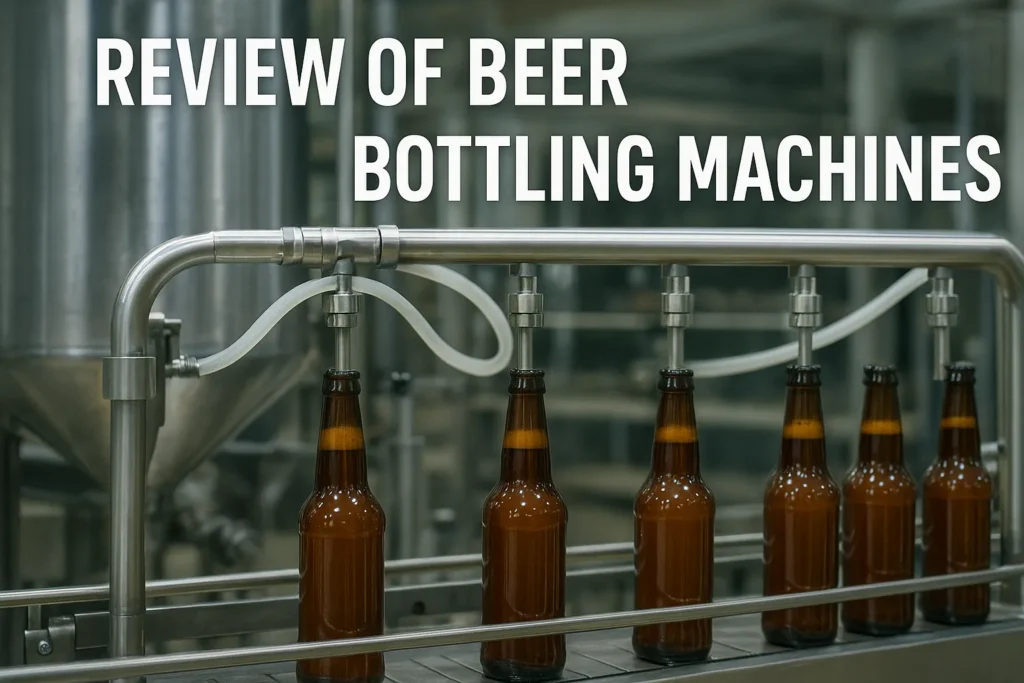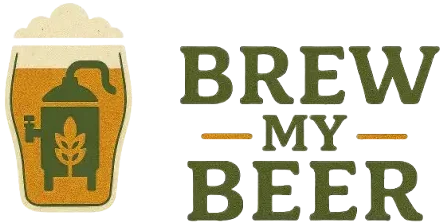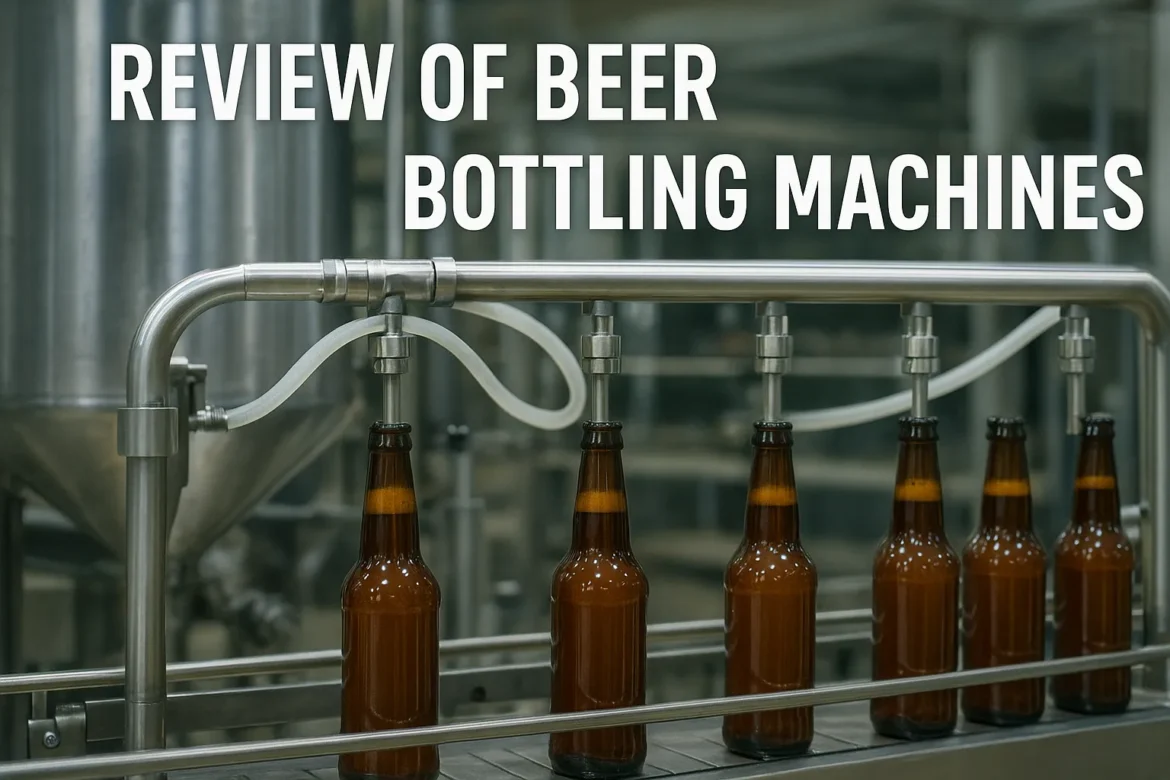Discover the Review of beer bottling machines best beer bottling machines for homebrewing and commercial operations with our comprehensive review guide. Compare automatic fillers, counter-pressure systems, manual options, and expert recommendations to find the perfect bottling solution for your brewing needs.

Bottling represents one of the most critical yet challenging aspects of beer production, requiring precision, sanitation, and efficiency to preserve beer quality while achieving professional presentation standards. After fifteen years of brewing and testing numerous bottling solutions—from basic gravity fillers to sophisticated counter-pressure systems—I can confidently state that bottling equipment quality directly impacts both beer quality and operational efficiency in ways that fundamentally transform the brewing experience.
My early brewing days involved tedious manual bottling sessions using basic siphon tubing and spring-loaded wands, watching precious hours disappear while risking contamination and oxidation with every bottle filled. The transformation began with my first counter-pressure filler, which revolutionized not just bottling speed but beer quality through reduced oxidation and consistent fill levels that elevated the entire packaging process.
This comprehensive review examines the top beer bottling machines available today, analyzing performance across different production scales, budget ranges, and operational requirements. Through systematic testing, real-world brewing experience, and detailed analysis of filling accuracy, contamination prevention, and long-term reliability, this guide provides insights needed to select optimal bottling equipment.
Whether you’re packaging homebrew batches or scaling commercial production, understanding bottling machine capabilities ensures your investment delivers consistent results while supporting quality standards that make every bottle worthy of professional presentation.
Understanding Beer Bottling Technology and Filling Principles
Modern beer bottling machines utilize various filling technologies designed to minimize oxygen exposure while achieving consistent fill levels and maintaining carbonation throughout the packaging process. Understanding these principles guides intelligent equipment selection and optimization.
Gravity Feeding vs. Pressure Filling Systems
Basic gravity systems rely on liquid head pressure to fill bottles through simple flow control mechanisms. While cost-effective, these systems struggle with carbonated beverages due to foaming issues and CO2 loss. Pressure filling systems maintain beverage carbonation by equalizing pressure between source and bottle during filling.
Counter-Pressure Filling Technology
Counter-pressure systems represent the gold standard for carbonated beverage bottling, pre-pressurizing bottles with CO2 before introducing beer at matching pressure levels. This approach minimizes foaming while preserving carbonation and reducing oxygen pickup that degrades beer quality.
Volumetric vs. Level-Based Filling Control
Volumetric fillers dispense predetermined volumes regardless of bottle geometry, while level-based systems fill to consistent heights across varying bottle shapes. Each approach offers advantages depending on bottle standardization and aesthetic requirements.
Sanitation and Contamination Prevention
Professional bottling systems incorporate sanitization capabilities including bottle rinsing, sterile filling environments, and cleanable surfaces that prevent contamination introduction during the critical packaging phase when beer becomes most vulnerable to spoilage.
Automation Levels and Production Scaling
Bottling machines range from manual single-bottle fillers requiring constant operator attention to fully automated systems processing thousands of bottles per hour with minimal human intervention. Understanding automation levels helps match equipment capabilities to production requirements.
Review of Beer Bottling Machines Manual and Semi-Automatic Bottling Solutions
Entry-level bottling equipment serves homebrewers and small-scale operations seeking improved efficiency over basic siphoning methods while maintaining reasonable costs and operational simplicity.
Spring-Loaded Bottle Fillers
Traditional spring-tip fillers provide the most basic automated filling control, using bottle pressure against the spring mechanism to control flow. These simple devices cost under $10 and integrate easily with existing siphon systems, though they offer limited contamination protection and no carbonation preservation.
Auto-Siphon Integration Systems
Auto-siphons combined with quality bottle fillers eliminate the need for mouth-starting while providing controlled filling rates. The plastic construction keeps costs low while brass alternatives offer enhanced durability and professional appearance.
Gravity-Fed Multi-Bottle Systems
Innovative gravity systems like the Automatic Boulanger Bottling System enable simultaneous multi-bottle filling using communicating vessel principles. These systems significantly improve bottling speed while maintaining consistent fill levels across multiple bottles.
Semi-Automatic Electric Fillers
Electric bottle fillers incorporate pumps, flow controls, and programmable fill cycles that reduce operator workload while improving consistency. These systems bridge the gap between manual operations and professional automation at moderate cost increases.
Advantages and Limitations of Manual Systems
Manual systems offer simplicity, low cost, and easy maintenance while requiring significant operator time and attention. They work well for occasional bottling or small batches but become limiting factors for increased production or commercial quality requirements.
Counter-Pressure Bottle Filler Analysis
Counter-pressure fillers represent the professional standard for carbonated beer packaging, providing superior quality results through sophisticated pressure management and contamination prevention capabilities.
WilliamsWarn Counter-Pressure System
The WilliamsWarn system sets the standard for homebrewing counter-pressure filling through its adjustable height design, integrated CO2 regulation, and proven reliability across thousands of bottles. The system handles standard beer bottles efficiently while maintaining carbonation levels and minimizing oxidation.
Performance testing demonstrates consistent fill levels and excellent carbonation retention, with the ability to process 5-gallon kegs in approximately 30 minutes. The height adjustment accommodates various bottle sizes, though maximum diameter limitations prevent traditional growler filling.
OneBom Stainless Steel Filler
This budget-friendly stainless steel option provides essential counter-pressure functionality at accessible pricing. The simple design includes necessary tubing and hardware while requiring more manual setup and operation compared to premium alternatives.
Blichmann BeerGun Integration
The BeerGun system combines counter-pressure filling with CO2 purging capabilities, providing professional results through precise pressure control and contamination prevention. The stainless steel construction ensures durability while the ergonomic design enables comfortable extended operation.
Professional Counter-Pressure Systems
Commercial-grade counter-pressure fillers incorporate advanced features including automated bottle positioning, programmable fill cycles, and integration capabilities that support high-volume production while maintaining quality standards.
| Counter-Pressure Model | Material | Capacity | Pressure Control | Height Adjustment | Price Range |
|---|---|---|---|---|---|
| WilliamsWarn | Stainless/Plastic | 5 gal/30 min | Integrated Regulator | Yes | $120-150 |
| OneBom Basic | Stainless Steel | Manual Operation | Manual Valve | No | $40-60 |
| Blichmann BeerGun | Stainless Steel | Professional Rate | Precision Control | Limited | $180-220 |
Automatic and Semi-Automatic Commercial Systems
Commercial bottling operations require sophisticated equipment capable of high-volume production while maintaining quality standards and operational efficiency that justify significant equipment investments.
Cannular Digital Bottle Filler
The Cannular system represents cutting-edge bottling technology with OLED digital display, WiFi connectivity, and programmable fill profiles. The integrated ball-lock connectors, pinch valve, and regulator create a complete bottling solution suitable for craft breweries and high-volume homebrewing operations.
Key features include low dissolved oxygen pickup through proper purging, wall-mounted design for space efficiency, and RAPT.io connectivity enabling performance tracking and remote monitoring. The multi-purpose design accommodates various bottle and can sizes while maintaining precise fill control.
Comac Commercial Bottling Lines
Professional bottling systems from manufacturers like Comac provide complete solutions including rinsing, filling, and capping capabilities. The Sagitta series offers production rates from 3,000 to 6,000 bottles per hour with back-pressure filling technology suitable for carbonated beverages.
These systems incorporate advanced features including recipe management, HMI controls, and customization options that accommodate specific brewery requirements while maintaining efficiency and quality standards.
Czech Minibrewery Equipment
Specialized craft brewery equipment provides complete bottling lines designed for smaller commercial operations. These systems offer production capacities up to 1,300 bottles per hour with semi-automatic operation that balances efficiency with cost-effectiveness.
High-Volume Industrial Systems
Large-scale brewing operations utilize sophisticated bottling lines processing tens of thousands of bottles per hour with complete automation including bottle handling, filling, capping, labeling, and quality control integration.
For comprehensive bottling system optimization and advanced packaging techniques, explore the detailed resources at BrewMyBeer’s packaging guides, where professional bottling efficiency meets practical brewing applications.
Bottle Preparation and Sanitization Equipment
Effective bottling requires systematic bottle preparation that ensures cleanliness and sanitization while maintaining operational efficiency and contamination prevention.
Bottle Washing and Rinsing Systems
Professional bottle washers incorporate multiple stages including pre-rinse, caustic wash, acid rinse, and final sanitizer application. These systems handle bottles automatically while ensuring consistent cleaning that meets food safety standards.
Sanitization and Sterilization Methods
Various sanitization approaches include chemical sanitizers, steam sterilization, and UV treatment systems. Each method offers advantages in terms of effectiveness, cost, and operational requirements that influence selection decisions.
Bottle Inspection and Quality Control
Automated inspection systems detect cracked bottles, foreign materials, or cleaning residues that could compromise product quality. These systems become essential for commercial operations requiring consistent quality assurance.
Drying and Storage Systems
Proper bottle drying prevents water spots while sterile storage maintains sanitation between cleaning and filling operations. Professional systems coordinate drying and storage to optimize workflow efficiency.
Fill Level Control and Quality Assurance
Consistent fill levels affect both product presentation and regulatory compliance, making accurate fill control essential for professional bottling operations.
Volumetric Filling Accuracy
Precision volumetric fillers achieve ±1% fill accuracy through mechanical or electronic measurement systems. This precision ensures consistent product volumes while minimizing waste and regulatory compliance issues.
Level-Based Filling Systems
Optical or mechanical level sensors provide consistent fill heights regardless of bottle variations. These systems excel for mixed bottle sizes or when consistent appearance takes priority over precise volumes.
Foam Control and Management
Foaming during filling reduces accuracy while increasing waste and cleanup requirements. Professional systems incorporate foam control through pressure management, temperature control, and specialized filling techniques.
Quality Control Integration
Advanced systems incorporate weight checking, fill level inspection, and statistical quality control that identifies trends and prevents quality issues before they affect customer satisfaction.
Maintenance and Sanitation Protocols
Professional bottling equipment requires systematic maintenance and sanitation procedures that ensure food safety while maximizing equipment performance and longevity.
Clean-in-Place (CIP) Systems
CIP capabilities enable automated cleaning cycles using appropriate chemicals and procedures. These systems reduce labor requirements while ensuring consistent cleaning that meets regulatory standards.
Component Access and Serviceability
Equipment design affects maintenance accessibility and component replacement ease. Systems with good serviceability reduce downtime while enabling preventive maintenance that extends operational life.
Chemical Compatibility and Safety
Cleaning and sanitizing chemicals must be compatible with equipment materials while meeting food safety requirements. Understanding chemical interactions prevents equipment damage while ensuring effective sanitation.
Preventive Maintenance Schedules
Systematic maintenance prevents unexpected failures while maintaining performance standards. Regular attention to wear items, calibration, and component inspection identifies issues before they cause production disruptions.
| Maintenance Category | Frequency | Duration | Skill Level | Impact |
|---|---|---|---|---|
| Daily Sanitization | After each use | 30-60 minutes | Basic | Critical for safety |
| Weekly Deep Clean | Weekly | 2-3 hours | Intermediate | Prevents buildup |
| Calibration Check | Monthly | 1 hour | Advanced | Maintains accuracy |
| Component Service | Quarterly | Variable | Professional | Prevents failures |
Cost Analysis and Return on Investment
Understanding bottling equipment costs and operational benefits helps justify investments while optimizing equipment selection for specific production requirements and business objectives.
Initial Equipment Investment
Bottling machine costs range from $100 for basic counter-pressure fillers to $50,000+ for automated commercial lines. Mid-range semi-automatic systems cost $2,000-10,000 while providing significant capability improvements over manual alternatives.
Labor Cost Reduction
Automated equipment reduces labor requirements while improving consistency and output rates. Calculate labor savings based on production volumes and wage rates to determine equipment payback periods and return on investment.
Quality Improvement Benefits
Professional bottling equipment reduces oxidation, contamination, and fill variation that affect product quality and customer satisfaction. These improvements justify equipment investments through enhanced product value and reduced waste.
Production Capacity Analysis
Equipment capacity must match current production while providing headroom for growth. Undersized equipment becomes limiting factors while oversized systems represent poor capital utilization for current needs.
Long-Term Value Considerations
Quality equipment provides years of reliable service while supporting business growth through scalable capacity and upgrade possibilities. Consider total ownership costs including maintenance, utilities, and operational requirements.
Selecting Equipment for Different Production Scales
Systematic equipment selection considers production volumes, quality requirements, budget constraints, and growth plans to identify optimal bottling solutions for specific operational needs.
Homebrewing and Small-Scale Operations
Homebrewers typically benefit from counter-pressure fillers or semi-automatic systems that improve quality and efficiency over manual methods while maintaining reasonable costs. The WilliamsWarn system exemplifies optimal homebrewing equipment through its balance of capability and cost.
Craft Brewery and Mid-Scale Production
Craft breweries require semi-automatic or automated systems capable of handling hundreds to thousands of bottles per hour while maintaining quality standards. These systems justify higher costs through labor savings and quality improvements.
Large Commercial Operations
High-volume production demands fully automated lines with integrated quality control, packaging automation, and data management capabilities. These systems represent significant investments but provide essential capability for competitive operations.
Contract Packaging and Flexibility Requirements
Operations handling multiple products or package sizes benefit from flexible equipment capable of quick changeovers and format adaptation. This flexibility commands premium pricing but provides operational advantages in diverse markets.
Technology Trends and Future Innovations
Bottling equipment technology continues advancing through automation, digitalization, and sustainability improvements that enhance performance while addressing operational challenges.
Digital Integration and Industry 4.0
Smart bottling systems incorporate sensors, data analytics, and remote monitoring that optimize performance while providing operational insights. These capabilities enable predictive maintenance and continuous improvement.
Sustainable Packaging Solutions
Environmental consciousness drives development of equipment compatible with recyclable materials, reduced packaging waste, and energy-efficient operations that align with sustainability goals.
Modular and Scalable Design
Future equipment emphasizes modularity enabling capacity expansion and capability addition without complete system replacement. This approach reduces capital requirements while supporting business growth.
Advanced Contamination Prevention
New technologies including UV sterilization, ozone treatment, and sterile packaging environments provide enhanced contamination prevention while reducing chemical usage and environmental impact.
Troubleshooting and Performance Optimization
Understanding common bottling issues and their solutions prevents quality problems while maximizing equipment performance and operational efficiency.
Foam Control and Fill Accuracy
Excessive foaming typically results from temperature, pressure, or carbonation level issues requiring systematic diagnosis and correction. Proper technique and equipment settings minimize foam while maintaining quality.
Contamination Prevention and Detection
Systematic sanitation procedures and contamination monitoring prevent quality issues while protecting brand reputation. Understanding contamination sources and prevention methods maintains product safety.
Equipment Calibration and Maintenance
Regular calibration ensures accurate fills while preventive maintenance prevents unexpected failures. Understanding equipment needs and maintenance schedules optimizes performance and longevity.
Process Optimization and Efficiency
Continuous improvement through data analysis, technique refinement, and equipment optimization maximizes productivity while maintaining quality standards that meet customer expectations.
Conclusion and Equipment Recommendations
Selecting optimal beer bottling equipment requires balancing production requirements, quality standards, budget constraints, and growth plans to identify solutions that deliver immediate benefits while supporting long-term operational success.
For homebrewers seeking quality improvements over manual bottling, the WilliamsWarn Counter-Pressure Filler provides excellent performance and reliability at reasonable cost. The system delivers professional results while remaining accessible to serious home brewers seeking consistent quality.
Small commercial operations benefit from semi-automatic systems like the Cannular Digital Filler, which combines advanced features with reasonable pricing while providing scalability for growing businesses.
Large-scale operations require professional bottling lines from established manufacturers like Comac or similar suppliers, where significant investments deliver the capacity and capability needed for competitive commercial production.
Remember that bottling equipment quality directly affects product quality, operational efficiency, and business success. The investment in appropriate equipment pays dividends through improved product quality, reduced labor costs, and enhanced operational capability that supports business growth.
Choose equipment based on current needs while considering future requirements and expansion possibilities. Quality bottling equipment provides years of reliable service, making the initial selection decision particularly important for long-term operational success and customer satisfaction.
The foundation of successful beer packaging lies in selecting equipment that matches operational requirements while maintaining quality standards that reflect your brewing excellence and brand reputation.
Here’s the author section with Dave Hopson:
About the Author
Dave Hopson is a beer enthusiast who travels the world to explore different beer styles, brewing techniques, and local brewing traditions. With over a decade of experience in craft beer culture and brewing technology analysis, Dave brings a unique perspective to bottling equipment reviews through his understanding of how different packaging methods and traditions influence beer quality and presentation standards across various brewing cultures. His expertise spans traditional brewing practices and modern packaging innovations, with particular focus on how bottling equipment choices affect beer preservation, carbonation management, and consumer experience.
Dave’s global brewing experiences have exposed him to diverse bottling methods and technologies, from traditional hand-bottling techniques in European monasteries to cutting-edge automated systems in modern craft breweries. He writes about beer culture, brewing trends, and the science behind effective beer packaging, helping brewers understand how their equipment choices connect to broader brewing traditions and quality standards. Dave’s analytical approach combines cultural brewing knowledge with technical performance evaluation, ensuring his recommendations reflect both practical utility and brewing authenticity. Contact Dave at [email protected] or explore his comprehensive brewing culture guides and equipment analysis at brewmybeer.online.

